Inside The New York Botanical Garden
Archive: May 2009
Posted in Programs and Events, Wildlife on May 29 2009, by Plant Talk
Spring Brings Special Sightings
 |
Debbie Becker leads a free bird walk at the Garden every Saturday from 11 a.m. to 12:30 p.m., beginning at the Reflecting Pool in the Leon Levy Visitor Center. The last one for the season will be June 27.
|
Three fuzzy heads can be seen bobbing up and down in the red-tailed hawk nest. Just like Central Park’s Pale Male and Lola, our red-tails have made a neat little “cliffside” home at the top of a structure—in this case the Library building. It is interesting to watch mom and pop fly in with food to feed the babies. The hawks’ diet consists mainly of small mammals (such as squirrels and chipmunks) and birds, keeping the balance of nature in check. The female red-tail seems to find mockingbirds a special treat and has resorted to robbing mockingbird nests. Recently, we saw the red-tail perched atop the Watson Building with a baby mockingbird in her talons and mother mocker desperately trying to get mother hawk to free her prey. The mocker aggressively attacked the hawk, but in the end the hawk had a meal for her babies and the mocker went home to an empty nest. It is the circle of life.
While searching for warblers in the Forest we were treated to a very rare sight at this time of year: Our well-hidden female great horned owl flew from her perch followed by her fledgling. We were able to follow the mature owl to a new perch but lost the young owl in the leaves. As we watched the mom settle in, she kept looking around for her baby. Suddenly she looked forward and began to hoot. Then she turned her head right and hooted and then left and hooted. I guess she heard the young owl reply, because she closed her eyes and seemingly went to sleep.
 As the warbler numbers begin to dwindle, the birds having moved on to northern climes, we are grateful for another wonderful migration. Most of us were treated to the sightings of warblers such as black-throated blue, black-throated green, northern parula, Tennessee, chestnut-sided, bay-breasted, American redstart, common yellowthroat, yellow, prothonotary, and ovenbird. We also had warbling, red-eyed, and blue-headed vireos and a long list of other spectacular birds: Baltimore oriole, scarlet tanager, rose-breasted grosbeak, wood thrush, veery, hermit thrush, gray catbird, brown creeper, house wren, rough-winged swallow, bank swallow, tree swallow, chimney swift, eastern kingbird, great blue heron, great egret, night-heron, green heron (in full breeding plumage, see above photo, courtesy Debbie Becker), cormorant, wood duck (adults with 11 babies), mallard (adults with 12 babies) indigo bunting, cedar waxwing, savannah sparrow, ruby-throated hummingbird, eastern towhee, and northern flicker.
As the warbler numbers begin to dwindle, the birds having moved on to northern climes, we are grateful for another wonderful migration. Most of us were treated to the sightings of warblers such as black-throated blue, black-throated green, northern parula, Tennessee, chestnut-sided, bay-breasted, American redstart, common yellowthroat, yellow, prothonotary, and ovenbird. We also had warbling, red-eyed, and blue-headed vireos and a long list of other spectacular birds: Baltimore oriole, scarlet tanager, rose-breasted grosbeak, wood thrush, veery, hermit thrush, gray catbird, brown creeper, house wren, rough-winged swallow, bank swallow, tree swallow, chimney swift, eastern kingbird, great blue heron, great egret, night-heron, green heron (in full breeding plumage, see above photo, courtesy Debbie Becker), cormorant, wood duck (adults with 11 babies), mallard (adults with 12 babies) indigo bunting, cedar waxwing, savannah sparrow, ruby-throated hummingbird, eastern towhee, and northern flicker.
Read More
Posted in Learning Experiences on May 28 2009, by Plant Talk
Education Courses Tailor-Made for Groups
 |
Jeff Downing is Vice President for Education.
|
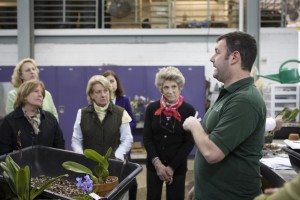 The first time I spoke with Ellen Conrad it was a long phone call. Not in a bad way—there was just a lot to say.
The first time I spoke with Ellen Conrad it was a long phone call. Not in a bad way—there was just a lot to say.
Ellen is the President of the Bedford Garden Club in Westchester County. She called looking for ways to provide high-quality educational content for her club members. With over 500 different courses offered for adults, I assured her that The New York Botanical Garden was certainly a good place to start. I explained that our 300-plus instructors included many of the Garden’s own staff—the world-class horticulturists who bring to life the stunning exhibitions and who care for the collections—in addition to a wide range of professional nurserymen and women, landscape designers, arborists, gardening authors, and others. All have both the knowledge of plant care and the ability to convey these skills in a classroom/workshop environment.
“But that’s just background!” I said. I was getting warmed up.
The Garden had never before customized a curriculum for a Garden Club (at least not in the 10 years I’ve been here), but for some time I had been contemplating the feasibility of such an arrangement. With the array of educational content, instructors, facilities, and resources available, the Garden could ostensibly design a customized curriculum to meet a group’s specific needs, schedule the classes around the group’s availability, and deliver a one-of-a-kind educational experience. All the Bedford Garden Club would need to do is get at least 15 of its members to enroll in the class—“to make it worth the investment of time to develop and schedule a specialized program like this,” I explained. “If you give me 15 students, I can teach you whatever you want. I mean, I could teach you Latin…OK, Botanical Latin, but you get the idea.”
“Wow!” Ellen exclaimed. Now she was as excited as I was. From there the conversation exploded into a dizzying back-and-forth of scheduling concepts, programming ideas, and possible follow-up opportunities down the road if the first course went well.
That was almost a year ago. Since then, the Garden has worked closely with the Bedford Garden Club to devise a tailored curriculum around essential horticulture principles within a schedule that accommodated their needs. Todd Forrest, the Garden’s Vice President for Horticulture and Living Collections, arranged a number of unique Curator-led workshops and special behind-the-scenes tours of Garden exhibitions, including The Orchid Show. When the eight-session course was offered last fall and winter, more than 20 club members participated and were enthusiastic about the results.
I saw Ellen Conrad a few weeks ago. I asked her whether the participants had any further thoughts now that they’ve had time to digest and reflect on the experience. “Sure,” she replied. “What’s next?”
To learn more about tailoring a curriculum for your garden club or interested group, contact Duncan Himmelman at 718.817.8741 or dhimmelman@nybg.org.
Posted in Science on May 27 2009, by Plant Talk
 |
Brian M. Boom, Ph.D., is Special Assistant to the President and Director of the Caribbean Biodiversity Program at the Garden.
|
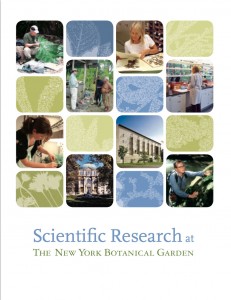 I have been around The New York Botanical Garden and involved in its scientific enterprise in one way or another for nearly three decades. Until now there has never been a publication as comprehensive as the one released last month that provides an overview of how the Botanical Garden’s scientific mission is realized. Scientific Research at The New York Botanical Garden features beautiful full-color photographs of work conducted both in the field and laboratory with informative text about current projects and facilities. It can currently be downloaded online.
I have been around The New York Botanical Garden and involved in its scientific enterprise in one way or another for nearly three decades. Until now there has never been a publication as comprehensive as the one released last month that provides an overview of how the Botanical Garden’s scientific mission is realized. Scientific Research at The New York Botanical Garden features beautiful full-color photographs of work conducted both in the field and laboratory with informative text about current projects and facilities. It can currently be downloaded online.
Following the Preface by the Chairmen of the Garden’s Botanical Science Committee, Edward P. Bass and George M. Milne, Jr., Ph.D., and Introduction by James S. Miller, Ph.D., Dean and Vice President for Science, the book is organized as Research Facilities and Collections; Research Programs and Projects; Faculty Research Profiles; Results Shared with the World; and Training, Science Education, and Collaboration, including lists of selected research grants and faculty publications.
One of the best ways to get to the heart of the Garden’s scientific activities is to browse through the research profiles of the 32 Ph.D. faculty members who comprise the core of the Garden’s scientific staff and who are assisted in their programs and projects by postdoctoral researchers and doctoral students. The team is further enhanced by Honorary Curators and Research Fellows and hundreds of additional local, national, and international collaborators.
Readers will learn about the state-of-the-art research and collections facilities located on a 23-acre science campus within the Garden’s 250-acre landmark grounds as well as in far-flung field locations around the world. Research results, many serving to inform plant conservation and sustainable development policies, are regularly disseminated through books and journals of The New York Botanical Garden Press and increasingly via electronic catalogs and publications available from our C.V. Starr Virtual Herbarium.
For those who want to discover even more, consider attending special lectures and symposia offered by the Garden, signing up for a Continuing Education class, or participating in the ecotour Ten Days in Brazil (October 10–21, 2009). Readers inspired to support the Garden’s scientific activities by volunteering and/or making a donation can learn how by clicking here.
Posted in Gardening Tips on May 26 2009, by Sonia Uyterhoeven
It’s Time for the Chelsea Chop
 |
Sonia Uyterhoeven is Gardener for Public Education at The New York Botanical Garden. Join her each weekend for home gardening demonstrations on a variety of topics in the Home Gardening Center. |
For those of you who grow sweet peas from seed, you will know from experience that once the seedlings reach 4–6 inches tall, you need to pinch them back to approximately half their height to encourage good branching. Some people pinch just once, other pinch twice— like most things in gardening, method is often based on personal preference.
If pinching seedlings with your fingertips sounds too dainty, then just wait until late May or early June, the time to grab your sheers or pruners and try them out in the garden on a larger and more satisfying scale…but not on your sweet peas, please.
In England they call cutting back perennials the “Chelsea Chop.” This is because the time for cutting back perennials lands on the same week of the famous Chelsea Flower show (the third week of May). Cutting back some (not all) perennials early in the season encourages lateral growth and produces nice and bushy (if not slightly shorter) plants.
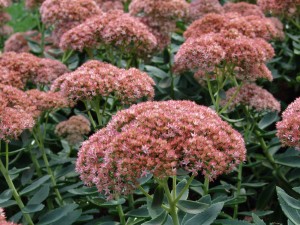
What are some candidates for this treatment?
Sedums (Sedum), pictured: Chop them in half in late May and you will prevent them from opening up and falling over later in the season.
Montauk daisies (Nipponanthemum): They often relish being chopped twice in the season, which keeps them from splitting open once they are in bloom.
Asters (Aster) and chrysanthemums (Chrysanthemum): If you are meticulous and have just a few, you can pinch them by hand by taking your thumb and forefinger and pinching off the growing tip of the plant (generally a half inch to 2 inches from the top). Let the plant grow a couple weeks until it puts on 2 or 3 nodes and then pinch again. For those of you who are as impatient as I am, just chop them in half once and then walk away.
Read More
Posted in Learning Experiences on May 22 2009, by Plant Talk
Explore, Plant, Scavenge, and Create a Field Journal
 |
Andrew Haight is Manager of the Everett Children’s Adventure Garden. |
Many bright ideas were brought to the table when the Children’s Adventure Garden staff first discussed programming for the spring bulb show, The Glory of Dutch Bulbs. Several exciting suggestions emerged from this creative conversation, which gave life to Bulbs Unearthed.
The Everett Children’s Adventure Garden always tries to find new ways for young children and their families to explore nature and plants through their five senses. As a result, the Bulbs Unearthed program provides the youngest learners with a tactile, interactive experience.
Facilitated by members of the Intern Explainer program for teenagers, visitors to the Adventure Garden learn how bulbs are neatly packaged containers of plant parts. When given the right conditions, they will grow into next year’s plants and will flower. After taking a close look at these parts inside the bulb, children can plant their own bulb in a biodegradable pot to take home. Children can also make a field notebook and go on a scavenger hunt around the Adventure Garden to search for signs of bulbs. Then they can complete the activities by making a paper iris flower.
Beyond bulbs, the Adventure Garden is home to many exciting spring awakenings. Sit outside on the benches and watch the robins nesting in the eaves of the Discovery Center or rest beneath the shade of the Pond Pavilion while mallards graze for duckweed or marvel at the caterpillar, ladybug, and frog topiaries. Come and enjoy all of these exciting opportunities with us.
Check out all of Saturday’s programming
Check out all of Sunday’s programming
Posted in Wildlife on May 21 2009, by Plant Talk
Parents Believed to Be Fordham U. Pair
 |
Richard Fleisher is a professor of Political Science at Fordham University. He has been keeping watch at the red-tailed hawk nest at The New York Botanical Garden and chronicling the activity of the nestlings. Additional photos of the red-tailed hawks can be seen on his Web site.
|
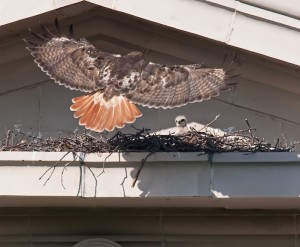 For the past four years I have watched and photographed two red-tailed hawks nest, hatch, nurture, and successfully fledge 11 young red-tails at Fordham University. The pair were named “Hawkeye” after Fordham alum Alan Alda’s character in M*A*S*H and “Rose” for Rose Hill, the Bronx campus of the University. Hawkeye is lighter in color than Rose, who has a distinctive band on her right leg. I had grown accustomed to watching this pair each spring as they fortified the nest on Collins Hall in preparation of another breeding cycle. In April the eggs would hatch, and soon young hawks that looked like little cotton balls would be visible through my scope. Very quickly these hatchlings (usually three) would get bigger, and by June they would be seen fledging (leaving the nest).
For the past four years I have watched and photographed two red-tailed hawks nest, hatch, nurture, and successfully fledge 11 young red-tails at Fordham University. The pair were named “Hawkeye” after Fordham alum Alan Alda’s character in M*A*S*H and “Rose” for Rose Hill, the Bronx campus of the University. Hawkeye is lighter in color than Rose, who has a distinctive band on her right leg. I had grown accustomed to watching this pair each spring as they fortified the nest on Collins Hall in preparation of another breeding cycle. In April the eggs would hatch, and soon young hawks that looked like little cotton balls would be visible through my scope. Very quickly these hatchlings (usually three) would get bigger, and by June they would be seen fledging (leaving the nest).
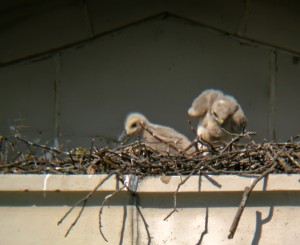 This spring, however, was different—there were no signs of the adult pair engaging in this practice. For sure, in early winter I would see them perched atop some of their favorite high spots on the campus. But when February became March and there continued to be no activity, I figured something was up. Sure enough, I got word that a pair of red-tails was nesting on the Library building at the Botanical Garden. I gathered my equipment, including my scope, cameras, 500mm lens, and tripod, to investigate the report of this new nest.
This spring, however, was different—there were no signs of the adult pair engaging in this practice. For sure, in early winter I would see them perched atop some of their favorite high spots on the campus. But when February became March and there continued to be no activity, I figured something was up. Sure enough, I got word that a pair of red-tails was nesting on the Library building at the Botanical Garden. I gathered my equipment, including my scope, cameras, 500mm lens, and tripod, to investigate the report of this new nest.
Though I cannot be sure, I am fairly confident that the pair of red-tails in the Botanical Garden is the same pair that spent the past four years on the Fordham campus. The similarities between the two nests are quite striking—both were built on a pediment of a frequently used building. In addition, it strikes me as too much of a coincidence that the same year the Fordham nest was abandoned a new nest was built by red-tailed hawks at NYBG. Finally, I got a close-up photo of the female and can see that she has a band on her right leg. (For more on the debate about whether the pair is Hawkeye and Rose, click here.)
As was the case in previous years, the pair produced three increasingly active hatchlings, which are now visible in the nest.
To learn more about the Botanical Garden red-tailed hawk nestlings…
Read More
Posted in Science, Shop/Book Reviews on May 20 2009, by Plant Talk
 |
Douglas Daly, Ph.D., is Director of the Institute of Systematic Botany and B.A. Krukoff Curator of Amazonian Botany. He is the co-author, along with Beth Ellis, Leo Hickey, Kirk Johnson, John Mitchell, Peer Wilf, and Scott Wing, of the newly released Manual of Leaf Architecture, published by NYBG Press. In this blog entry, Doug describes the invaluable information the book provides.
|
Often we can distinguish two unrelated plants just from their leaves, even if the leaves are similar in size and shape, but how do we pinpoint those differences and put them into words? Similarly, foresters in the tropics need to be able to distinguish valuable timber trees from closely related tree species that may be endangered or have poor quality wood, but what characteristics can they use to detect those species? Other scientists who study the plants of the distant past need to be able not only to separate leaf fossils but also to quantify how many of the same species are found at a given site; how can they do that consistently?
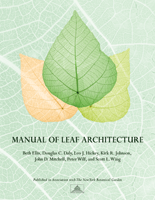 Until now, plant classification and identification have relied heavily on flowers and fruits, but these structures are not present most of the year. Moreover, fossil leaves are almost never found together with reproductive parts. Leaves display a wealth of characteristics that can be diagnostic at the level of genus or even species, but there wasn’t a logically ranked system that defined, described, and illustrated these characteristics. My co-authors and I wrote the Manual of Leaf Architecture precisely to provide an exhaustive, comprehensively illustrated reference for thoroughly describing the leaves of flowering plants, especially their vein patterns.
Until now, plant classification and identification have relied heavily on flowers and fruits, but these structures are not present most of the year. Moreover, fossil leaves are almost never found together with reproductive parts. Leaves display a wealth of characteristics that can be diagnostic at the level of genus or even species, but there wasn’t a logically ranked system that defined, described, and illustrated these characteristics. My co-authors and I wrote the Manual of Leaf Architecture precisely to provide an exhaustive, comprehensively illustrated reference for thoroughly describing the leaves of flowering plants, especially their vein patterns.
In our reasearch and writing we were able to draw fundamental conclusions about the evolution, ecology, diversity, and management of ecosystems and plant resources, based on identifications and characterizations that in turn are based on leaves. This reference puts all that work on a more secure footing.
Editor’s note: Manual of Leaf Architecture is receiving rave reviews. Lawren Sack of UCLA considers it a major contribution that will “revolutionize the study of leaves” and says it is “analogous to the first manual on human anatomy.” Sir Peter Crane of the University of Chicago calls it “indispensable” for researchers.
Posted in Uncategorized on May 19 2009, by Plant Talk
“Greening” Existing Buildings Works Toward Mayor’s Proposal
 |
Daniel Avery is Sustainability and Climate Change Program Manager at The New York Botanical Garden. |
On Earth Day last month, City Council Speaker Christine Quinn and Mayor Mike Bloomberg announced major new legislative proposals to increase energy efficiency in existing buildings. The measures, some of which will no doubt prove controversial (and, perhaps in some cases, difficult politically to get through), are a response to the reality of reducing emissions in a densely urban setting.
As perhaps you noticed the last time you strolled around your city block (or any city block), there are buildings everywhere, and collectively they contribute the vast majority—about 80 percent—of New York City’s greenhouse gases. In addition, of the buildings that will be standing in 2030, the date by which the Mayor’s PlaNYC 2030 envisions a 30 percent reduction in greenhouse gases from 2005 levels, 90 percent have already been built. This is why Rohit Aggarwala, Director of the Mayor’s Office of Long-Term Planning and Sustainability, said to The New York Times regarding the proposed legislation: “Existing buildings are in fact the nut that must be cracked if we are ever going to make a dent on the demand side in terms of energy.”
In terms of buildings, The New York Botanical Garden is much like the city: We have a lot of buildings of many different ages performing an astonishing number of different tasks. We represent, in short, a microcosm of the City’s challenge to reduce building-related emissions. And over the years we have been quietly going at this problem. Such efforts are not as visible or as easy to explain as new green buildings (if you find the list below exciting, you’re officially a policy nerd), but in many ways they are more challenging and more important.
Read More
Posted in Gardening Tips on May 18 2009, by Sonia Uyterhoeven
How to Water Newly Planted Trees
 |
Sonia Uyterhoeven is Gardener for Public Education at The New York Botanical Garden. Join her each weekend for home gardening demonstrations on a variety of topics in the Home Gardening Center. |
Newly planted trees are thirsty for water. On the day of planting, give them a deep soaking; then come back the next day and soak them again. The ground around the root ball of the tree will take up most of the water from the first day, and the second watering ensures that the root ball gets soaked.
If you walk around The New York Botanical Garden, you will notice that around newly planted shrubs and trees is a small berm of soil (part of the backfill). What we have done, basically, is to build a saucer around the woody plant that will help retain water.
The saucer should be the size of the root ball. When water is added to this makeshift well, it penetrates into the root ball (and hence the roots) rather than seeping into the disturbed soil around the plant. The berm should be broken down after several months and certainly by the end of the growing season. Distribute the soil away from the tree so that you do not alter the soil level around the root ball
The easiest way for a homeowner to water a newly planted tree or shrub is to lay a hose at the base of the tree and run a slow trickle of water for several hours until the soil is thoroughly soaked. It is better to water your tree once a week with a deep soak than to water it frequently for a short time (which produces a shallow, weak root system).
For additional tips on watering newly planted trees…
Read More
Posted in Programs and Events on May 15 2009, by Plant Talk
Plant Edible Bulbs, Weave Onion-Dyed Cloth, and More
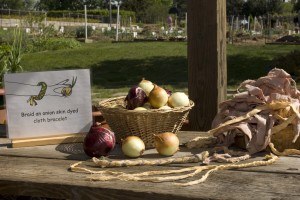 Here’s a sight not often seen at the Howell Family Garden: Toby Adams, Manager, holding back tears.
Here’s a sight not often seen at the Howell Family Garden: Toby Adams, Manager, holding back tears.
Truth be told, I didn’t see it either. One morning I wandered into the Family Garden by following the tasty smell of soup. Alas, it was not lunchtime. I learned instead, that in preparation for Bulbs Unearthed, part of the Dig, Plant, Grow! program at the Howell Family Garden, Toby and staff the previous afternoon had peeled several hundred onions in an act that must have made several grown men cry. Then they boiled the skins into a Macbethian brew of yellow and green dyes. Into this concoction went strips of cloth. After a brewing period, the fabric was set to dry in the sun. The end result of all that labor? Beautiful honey-colored material ready to be woven into bracelets by our visitors.
Our craft successes with onions so far have been most popular with folks with braiding experience. “More often than not, it’s the little girl teaching the father to braid,” staffer Junior Schoulton reports. Visitors not so adept at braiding, however, are welcomed to help our gardeners plant scallions or to use colored pencils to capture on paper the last tulip blooms fading from the meadow.
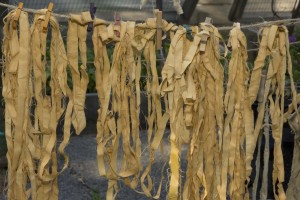 If all that isn’t enough, from 2 to 5 p.m. on June 6 and 7 staff from the Wyckoff Farmhouse Museum in Brooklyn will share traditional Dutch crafts with our visitors, such as they did this past weekend. The reception was enthusiastic: snacking on freshly churned butter with oregano, attempting to roll wooden hoops across the lawn, and decorating ceramic tiles were just a few of the activities the Wyckoff staff provided. Shirley, who happily operated the butter churn with the help of several visitors, confirmed the general enthusiasm. “The kids are loving it. Mostly it’s the parents who say, ‘That’s all there is to it? I’m going to make my own butter!’” Additional activities the Wyckoff staff will offer in June are apple pressing and ink-making as well as lessons in using quill pens.
If all that isn’t enough, from 2 to 5 p.m. on June 6 and 7 staff from the Wyckoff Farmhouse Museum in Brooklyn will share traditional Dutch crafts with our visitors, such as they did this past weekend. The reception was enthusiastic: snacking on freshly churned butter with oregano, attempting to roll wooden hoops across the lawn, and decorating ceramic tiles were just a few of the activities the Wyckoff staff provided. Shirley, who happily operated the butter churn with the help of several visitors, confirmed the general enthusiasm. “The kids are loving it. Mostly it’s the parents who say, ‘That’s all there is to it? I’m going to make my own butter!’” Additional activities the Wyckoff staff will offer in June are apple pressing and ink-making as well as lessons in using quill pens.
Although it’s a bummer to lose our tulip blossoms to the warming weather and heavy rain, I’ve noticed flowering onions’ purple tops puckering up by the pond. These gorgeous alliums allow the bulbs’ showy season to go out with a bang. My favorite bulb trick? Saving the giant alliums’ blooms to dry as Independence Day flower-fireworks!
Bulbs Unearthed will be featured in the Ruth Rea Howell Family Garden from 1:30 to 5:30 p.m. through June 7.
Check out all of Saturday’s programming
Check out all of Sunday’s programming

 As the warbler numbers begin to dwindle, the birds having moved on to northern climes, we are grateful for another wonderful migration. Most of us were treated to the sightings of warblers such as black-throated blue, black-throated green, northern parula, Tennessee, chestnut-sided, bay-breasted, American redstart, common yellowthroat, yellow, prothonotary, and ovenbird. We also had warbling, red-eyed, and blue-headed vireos and a long list of other spectacular birds: Baltimore oriole, scarlet tanager, rose-breasted grosbeak, wood thrush, veery, hermit thrush, gray catbird, brown creeper, house wren, rough-winged swallow, bank swallow, tree swallow, chimney swift, eastern kingbird, great blue heron, great egret, night-heron, green heron (in full breeding plumage, see above photo, courtesy Debbie Becker), cormorant, wood duck (adults with 11 babies), mallard (adults with 12 babies) indigo bunting, cedar waxwing, savannah sparrow, ruby-throated hummingbird, eastern towhee, and northern flicker.
As the warbler numbers begin to dwindle, the birds having moved on to northern climes, we are grateful for another wonderful migration. Most of us were treated to the sightings of warblers such as black-throated blue, black-throated green, northern parula, Tennessee, chestnut-sided, bay-breasted, American redstart, common yellowthroat, yellow, prothonotary, and ovenbird. We also had warbling, red-eyed, and blue-headed vireos and a long list of other spectacular birds: Baltimore oriole, scarlet tanager, rose-breasted grosbeak, wood thrush, veery, hermit thrush, gray catbird, brown creeper, house wren, rough-winged swallow, bank swallow, tree swallow, chimney swift, eastern kingbird, great blue heron, great egret, night-heron, green heron (in full breeding plumage, see above photo, courtesy Debbie Becker), cormorant, wood duck (adults with 11 babies), mallard (adults with 12 babies) indigo bunting, cedar waxwing, savannah sparrow, ruby-throated hummingbird, eastern towhee, and northern flicker.















